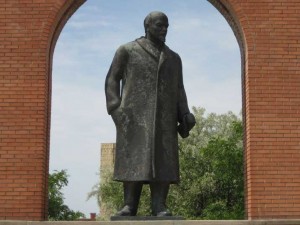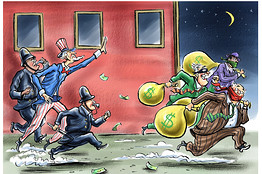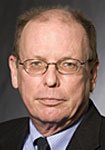Yesterday, Professor Gerard posted the course offerings for fall. One of those, which should interest students who seek a broad based 200 level course will be the history of economic thought. The registrar suggests that students should sign up for the actual course rather than for a tutorial. This will be possible after May 12th. The course was last taught by Professor LaRocque here in 2001. We have resurrected the course number and title. SO: sign up for ECON 330 – The Evolution of Economic Thought after May 12th. If you seek further information, please contact Professor Finkler.
Year: 2010
Monkey business
In Introductory Microeconomics, we have been discussing trade. We all know that Adam Smith wrote that trade was a result of people’s “propensity to truck, barter, and exchange one thing for another.” But did you know that he also wrote “Nobody ever saw a dog make a fair and deliberate exchange of one bone for another with another dog. Nobody ever saw one animal by its gestures and natural cries signify to another, this is mine, that yours; I am willing to give this for that.” (Wealth of Nations, Book I, Chapter II) This video calls all of that into question, it would seem (thanks to Adam King). On a related note, listen to this podcast from NPR to get an interesting perspective on early trade (thanks to Max Randolph).
Richard Florida Finds the Silver Lining
In a just published book entitled The Great Reset, Richard Florida explains how recessions can be Schumpeterian moments. See today’s Financial Times article on innovation inspired by economic recessions for some juicy examples.
See Your Future, Be Your Future…
Alright, folks, here is the unofficial unveiling of the courses coming for next year. If you don’t see what you think you should see here, get in touch with one of your friendly neighborhood LU economists and ask about possible independent and group study options.
Fall 2010
ECON 100 INTRODUCTORY MICROECONOMICS (Q) 9:50-11:00 MTWF Ms. Karagyozova
ECON 170 FINANCIAL ACCOUNTING 2:30-4:20 TR Mr. Vaughan
ECON 200 ECONOMIC DEVELOPMENT (G,W) 12:30-2:20 TR Mr. Finkler
ECON 390 HISTORY OF ECONOMIC THOUGHT 2:30-4:20 TR (Sign up for tutorial with Professor Finkler)
ECON 300 MICROECONOMIC THEORY (Q) 3:10-4:20 MTWF Mr. Gerard
ECON 430 CAPITAL AND GROWTH (Q) 9:00-10:50 TR Mr. Finkler
ECON 520 ADVANCED MACROECONOMICS (Q) 1:50-3:00 MWF Ms. Karagyozova
Yoram Bauman Stands Up for “Cap n Tax”
Standup economist Yoram Bauman was on campus all day, talking in two classes, brunching with interested students, and finally knocking us dead with his material from convex hulls (don’t ask if you aren’t a math-econ major), exotic grains (I always suspected quinoa was funny; now I’m convinced) and the American political spectrum. Bauman delivered what was certainly the funniest Povolny Lecture in the history of the series.
His primary work and his primary message has to do with climate change and the price of carbon. Bauman argues that a carbon tax of about $30 per ton would serve the dual purpose of reducing carbon use and generating revenue that could offset the reliance on distortionary taxes (e.g., sales and income taxes). His message is that this lunch isn’t free, the tax would translate into about $0.30/gallon on gasoline and $0.03/kWh on coal-generated electricity. And here’s the key to the message — these price increases are necessary in order to reduce the quantity demanded for fossil fuels in rich western countries. So, in that spirit, the idea of a cap and “tax” is perfectly consistent with the basic economics lesson: if you want to use the market to get people to buy less, then the so-called market signal is the higher price.
On behalf of the economics faculty and students, I’d like to thank Yoram for a great day and wish him the best in his careers.
TBA Time Once Again
After a week off, the Economics TeaBA is back and fighting mad.  Well, not really mad, but Professor Azzi was a bit upset that he bought a storehouse of cookies last week and we had a cancellation. Based on my current projections, today’s TBA will feature tea, coffee, cookies, and possibly a guest appearance by George Wyeth.
Well, not really mad, but Professor Azzi was a bit upset that he bought a storehouse of cookies last week and we had a cancellation. Based on my current projections, today’s TBA will feature tea, coffee, cookies, and possibly a guest appearance by George Wyeth.
The excitement starts at 4:15 p.m. in Briggs 217.
And, I’m certain that I don’t need to remind you about tonight’s Povolny Lecture featuring standup economist, Yoram Bauman, at 7:30 in Wriston Hall…
An Oz. of Prevention
 The indefatigable Ralph Nader came, he saw, he sold some books, and he raised some hell. Are you wasting the prime of your life with hang ups you should have dealt with as a teenager? Do you find yourself spending more time looking at yourself in the mirror than keeping tabs on Congress? Mr. Nader isn’t shy about asking the tough questions.
The indefatigable Ralph Nader came, he saw, he sold some books, and he raised some hell. Are you wasting the prime of your life with hang ups you should have dealt with as a teenager? Do you find yourself spending more time looking at yourself in the mirror than keeping tabs on Congress? Mr. Nader isn’t shy about asking the tough questions.
I was amazed and surprised with his digression on the 1872 Mining Law and his browbeating of the audience about our ignorance of the statute and its implications. Having done some research on the subject myself, I would put the ball back in his court. Does he know that environmental group opposition is stifling volunteer cleanups of abandoned mines? In this month’s Atlantic Monthly there is a short piece describing the situation. The basic problem is that there is a single policy instrument in place to prevent pollution and to govern cleanups. It turns out, this is like throwing one stone at two birds:
But as these volunteers prepare to tackle the main source of the pollution, the mines themselves, they face an unexpected obstacle—the Clean Water Act. Under federal law, anyone wanting to clean up water flowing from a hard-rock mine must bring it up to the act’s stringent water-quality standards and take responsibility for containing the pollution—forever. Would-be do-gooders become the legal “operators” of abandoned mines like those near Silverton, and therefore liable for their condition. In mid-October, Senator Mark Udall of Colorado introduced a bill that would allow such “good Samaritans” to obtain, under the Clean Water Act, special mine-cleanup permits that would protect them from some liability. Previous good-Samaritan bills have met opposition from national environmental organizations, including the Sierra Club, the Natural Resources Defense Council, and even the American Bird Conservancy, for whom any weakening of Clean Water Act standards is anathema.
In other words, it is the environmental groups who are standing in the way of environmental progress in this case. The reasons for this are straightforward, predictable, and understandable. It is all described cogently in this testimony on similar proposed legislation from ten years ago!
The sad state of affairs is that as the various groups dig in their heels, the acid drainage continues to pollute the waters in the west. Again, from The Atlantic:
Just a few miles from Silverton, in an icy valley creased with avalanche chutes, groundwater burbles out of the long-abandoned Red and Bonita gold mine. Loaded with aluminum, cadmium, and lead, it pours downhill, at 300 gallons a minute, into an alpine stream. The Silverton volunteers aren’t expecting a federal windfall anytime soon—even Superfund-designated mine sites have waited years for cleanup funding, and Udall’s bill has been held up in a Senate committee since last fall. Without a good-Samaritan provision to protect them from liability, they have few choices but to watch the Red and Bonita, and the rest of their local mines, continue to drain.
Super Crusader Ralph Nader Visits Lawrence
 One-time Presidential spoiler (just don’t tell him that) and always consumer-rights advocate (though economists might sometimes disagree) Ralph Nader will visit campus Sunday to deliver “The Great Conversion: Environmentalism over Corporatism.” The show is in the Chapel at 7:30, and Mr. Nader will be around to talk and sign books before and after his talk.
One-time Presidential spoiler (just don’t tell him that) and always consumer-rights advocate (though economists might sometimes disagree) Ralph Nader will visit campus Sunday to deliver “The Great Conversion: Environmentalism over Corporatism.” The show is in the Chapel at 7:30, and Mr. Nader will be around to talk and sign books before and after his talk.
Love him or hate him, Mr. Nader is certainly one of the more important figures of the last 50 years. Indeed, it would be hard to talk about the rise of safety and environmental policy without at least a hat-tip to Nader’s important role. The title of the talk suggests that he believes Americans actually buy into the message of environmentalism (however defined) over the types of results we’ve seen from corporatism (also, however defined). That’s a pretty provocative statement, and certainly Mr. Nader had no small role in fomenting these attitudinal changes. So, I encourage you to get over there and listen to what the man has to say.
Goldman Sachs and the Catholic Church: Two Cultures of Infallability
What do the Goldman Sachs and the Catholic Church have in common? Is this comparison fanciful? Even Goldman CEO Lloyd Blankfein opined that the firm was doing “God’s work.” See if you agree with Stephan Richter’s argument.
Lawrence Emeritus Professor Returns to Teach History of Economic Thought
The Economics Department is pleased to announce that Emeritus Professor of Economics Jules LaRocque will return this fall to teach a course in his specialty: the history of economic thought (see description below). This course will only be offered in the Fall term at the 2:30 – 4:20 time slot on Tuesdays and Thursdays. Timing prohibited publishing the course in the official course schedule prior to the registration period; therefore, if you are interested, please see or send an email to Professor Finkler. We are excited to provide this opportunity and encourage students to take advantage.
History of Economic Thought The course examines the origins and development of ideas pertaining to production and distribution of goods and services in ancient to modern civilizations. Special attention will be devoted to ideas (and their authors) that led to the emergence of market-oriented societies. Examples of such authors are Adam Smith, J.B. Say, David Ricardo, Karl Menger, Alfred Marshall, F.H. Knight, and J. M. Keynes. The Marxian and socialist challenges to the market-based ideas will also be examined.
The Fed’s Business Model Works
Today’s headlines reveal that the Federal Reserve Bank of the United States contributed its net income (PROFITS) of $47B to the Federal Government in 2009. It is required to do so by law. Those who go on the Chicago trip in May (or who read the article) will learn that the Fed is a regular contributor to governmental coffers. Furthermore, it’s not just seigniorage (for those of you in Econ 320.)
Learn, learn, learn…
…said the great Lenin—at least that is what we all heard in Soviet countries.
 I couldn’t find the source of the quote, but it is written in giant letters on buildings, carved into stone in numerous places in the former USSR, so it must be true. Well, the great Lenin was born exactly 140 years ago, on April 22 1870, as Vladimir Ilyich Ulyanov. Happy Birthday, Comrade! The living room window of the apartment where I spent much of my childhood faced the Lenin statue you see on the right. I am sure in a drawer back home there is a black-and-white photo of 10-year-old me bicycling around it… You can’t tell from this picture, but the statue is 4 meters tall.
I couldn’t find the source of the quote, but it is written in giant letters on buildings, carved into stone in numerous places in the former USSR, so it must be true. Well, the great Lenin was born exactly 140 years ago, on April 22 1870, as Vladimir Ilyich Ulyanov. Happy Birthday, Comrade! The living room window of the apartment where I spent much of my childhood faced the Lenin statue you see on the right. I am sure in a drawer back home there is a black-and-white photo of 10-year-old me bicycling around it… You can’t tell from this picture, but the statue is 4 meters tall.
Lenin, on the other hand, was rather short, but extremely persuasive, as this video will no doubt convince you. He came back from his exile in Switzerland just in time to lead the October Revolution.
 He wrote a lot, including some quotable bits such as “Where the bourgeois economists saw a relation between things (the exchange of one commodity for another) Marx revealed a relation between people.” He died after a stroke, which was confirmed in this study of his brain.
He wrote a lot, including some quotable bits such as “Where the bourgeois economists saw a relation between things (the exchange of one commodity for another) Marx revealed a relation between people.” He died after a stroke, which was confirmed in this study of his brain.
I could say a lot more, but I’d better get back to my five-year plan.
Standup Economist to Visit Lawrence
Students in economics will have two opportunities next Monday to hear and interact with Yoram Bauman, self-styled standup economist, who specializes in not only making the complex accessible but also humorous.
Students in Econ 280 and Econ 320 will hold a joint session on Monday morning at 9:50 in Science Hall 102. Other students are welcome to attend. Bauman will discuss Paul Krugman’s recent article ( here ) in the New York Times Magazine entitled “Building a Green Economy.”
Bauman will also be the second speaker in the Povolny Lecture Series on The Climate for Climate Change. His talk is entitled “Comedy, Economics, and Climate Change” and will take place in the Wriston Auditorium at 7:30 PM next Monday.
To get a snippet of his style or to see excerpts from his new Cartoon Introduction to Economics go here.
Figures Lie and All That
Carl Bialik of the Wall Street Journal takes a look at the grimy rot that is government economic statistics. It has probably occurred to you at some point that there is uncertainty about whether numbers like the Gross Domestic Product (GDP) actually measure economic activity or are a reasonable proxy for well being. What has not perhaps occurred to you is that maybe we aren’t all that certain about whether those numbers are accurate at all?
[A]t a time when high unemployment tops many people’s worries about the economic recovery, the BLS can say only that it is 90% confident that the true change in the number of unemployed in March was somewhere between a drop of 243,000 and an increase of 511,000. In other words, it isn’t even clear whether the number of unemployed rose or fell last month.
That emphasis is mine, and it is a point worth emphasizing.
Another important point, of course, is that it’s not my fault! Aside from the point that the numbers might not represent what we think they represent, it is also important to note that we are trying to measure things that are difficult to measure with questionable samples in a short time horizon. So always be sure to ask for the confidence interval.
Crony Capitalism in America: Unbelievable
 In today’s Wall Street Journal, Gerald O’Driscoll spells out on how theft and fraud have become commonplace. This is not a new story but a growing phenonmenon. The Goldman-Sachs and Lehman cases show how pervasive things are. The cartoon tells it all.
In today’s Wall Street Journal, Gerald O’Driscoll spells out on how theft and fraud have become commonplace. This is not a new story but a growing phenonmenon. The Goldman-Sachs and Lehman cases show how pervasive things are. The cartoon tells it all.
Lake Woebegone Goes to College
Have you ever wondered why your grade point average is so high? Is it because you close The Mudd every night? Your raw intelligence? Your unusually good problem-solving skills? Your avoidance of my classes?
Or maybe it’s because it’s 2010 and Lawrence is a private university. It seems that the average college GPA has been going up at the rate of about 0.1 per year for the past 50 years, with private schools leading the charge. Here’s Exhibit A:

That’s from the NYT‘s Economix column. The green series is the GPA for private schools over time, which appears to have started at about 2.3 in 1930 and increased to right around 3.3 today. That’s right, the average student at a private college has a 3.3. GPA. The grey dots show the data points surrounding the series, so this is no selection bias problem. In fact, the lowest average GPA in the sample (about 2.7) is higher than virtually every single recorded data point prior to 1950.
The big question, of course, is why? The answer to that is probably not so simple. We have seen one of the consequences, however — students really do work less these days. Recent scholarship documents an inverse relationship between the expected average class grade and the amount that students work. To wit: average study time would be about 50% lower in a class in which the average expected grade was an “A” than in the same course taught by the same instructor in which students expected a “C.” In other words, students are working less and getting higher grades.
One point of interest is that science classes have traditionally graded much more harshly than the humanities.
[S]cience departments today grade on average 0.4 points lower than humanities departments, and 0.2 points lower than social science departments. Such harsher grading for the sciences appears to have existed for at least 40 years, and perhaps much longer… Relatively lower grades in the sciences discourage American students from studying such disciplines, the authors argue.
So does that account for the dearth of American-born scientists — the fear of getting a B?
How do you suppose a maximizing professor should think about these issues? If I want to push my students, do I have to be a tough grader? Or do I just end up with fewer students grouching about how much work I give them?
Click on the “making the grade” tag for more on grade inflation.
13 Bankers or 1 Federal Puppet Master?
On the news that Goldman Sachs allegedly engaged in securities fraud and also posted $3.46 billion in quarterly earnings, the intersection of politics and high finance is of special interest. My Political Economy of Regulation class read Simon Johnson’s “Quiet Coup” about the cozy relationships between Wall Street and federal regulators as a possible example of capture theory (making a convincing case to some).
Now Johnson is back with 13 Bankers: The Wall Street Takeover and the Next Financial Meltdown, bolstering his case with the help of co-author James Kwak. Tyler Cowen reviews the book for The Huffington Post and comes to a much different conclusion:
Much as I admire their analysis and exposition, I see the problem a bit differently than they do. Whereas they see banks as the puppet master and our government as the fool, I wonder whether it is not more accurate to think of the government as running the show….
[N]amely that the U.S. government stands at the center of a giant nexus of money raising, most of all to finance the U.S. government budget deficit and keep the whole show up and running. The perception at least is that our country requires the dollar as a reserve currency, requires New York City as a major banking center with major banks, and requires fully credible governmental guarantees behind every Treasury auction and requires liquid financial markets more generally. Furthermore the international trade presence of the United States (supposedly) requires the federal government to strongly ally with major commercial interests, just as our government sides with Hollywood in trade and intellectual property disputes. To abandon banks is to send a broader message that we are in commercial and political decline and disarray, and that is hardly an acceptable way to proceed, at least not according to the standards of the real Washington consensus.
Back to square 1, I guess. I see a discretionary writing assignment for Friday on the horizon.
UPDATE: Russ Roberts interviews Johnson on EconTalk, and a summary of the interview.
Steppenwolf Theatre Director David Hawkanson ‘69 Discusses Challenges Facing Arts Organizations
From the Lawrence Press Releases blog: Steppenwolf Theatre Director David Hawkanson ‘69 Discusses Challenges Facing Arts Organizations.
(Environmental Policy) Change Isnt Easy, Tuesday at 7pm
 Lawrence alum, George B. Wyeth, will kick off the Povolny Lecture Series this Tuesday, April 20, at 7 p.m. in Science Hall 102. Mr. Wyeth picked up his B.A. from Lawrence back in 1973, notably serving as editor-in-chief of The Lawrentian. He leveraged his success here into a Masters in Public Policy at UC-Berkeley and a law degree from Yale. After a stint in the private sector, he joined the U.S. Environmental Protection Agency in 1989 and is now the Director at the National Center for Environmental Innovation.
Lawrence alum, George B. Wyeth, will kick off the Povolny Lecture Series this Tuesday, April 20, at 7 p.m. in Science Hall 102. Mr. Wyeth picked up his B.A. from Lawrence back in 1973, notably serving as editor-in-chief of The Lawrentian. He leveraged his success here into a Masters in Public Policy at UC-Berkeley and a law degree from Yale. After a stint in the private sector, he joined the U.S. Environmental Protection Agency in 1989 and is now the Director at the National Center for Environmental Innovation.
Well, to be accurate, right now he is the the Stephen Edward Scarff Memorial Visiting Professor, teaching a course on policy implementation with Professor Chong Do-Hah. His talk is “Change isn’t Easy: An Inside Perspective.” Like his course, the talk will address the public administration challenges of addressing environmental problems.
We hope to see you there.
The Long Ball
 So, did Major League Baseball’s steroid craze lead to the decimation of the baseball record book? The argument is straight forward enough, with the help of performance-enhancing drugs, hitters got bigger and stronger and started knocking the tater out of the park with alarming frequency. The extra-ordinary seasons from the likes of Mark McGwire, Sammy Sosa, and Barry Bonds are the proof in the steroid pudding.
So, did Major League Baseball’s steroid craze lead to the decimation of the baseball record book? The argument is straight forward enough, with the help of performance-enhancing drugs, hitters got bigger and stronger and started knocking the tater out of the park with alarming frequency. The extra-ordinary seasons from the likes of Mark McGwire, Sammy Sosa, and Barry Bonds are the proof in the steroid pudding.
But Art De Vany at UC-Irvine says it just isn’t so, and he just published a paper in Economic Inquiry making his case. The paper is appropriately titled “Steroids and Home Runs,” and it has a very direct and confident abstract:
There has been no change in Major League Baseball home run hitting for 45 yr, in spite of the new records. Players hit with no more power now than before. Records are the result of chance variations in at bats, home runs per hit, and other factors. The clustering of records is implied by the intermittency of the law of home runs. Home runs follow a stable Paretian distribution with infinite variance. The shape and scale of the distribution have not changed over the years. The greatest home run hitters are as rare as great scientists, artists, or composers.
Ah, where would we be without the Paretian distribution? If you don’t feel like plowing through the paper, you can hear him chat with Russ Roberts at EconTalk.
De Vany is quite a character. In addition to his academic prowess, he is a former professional athlete and a bona fide fitness and diet guru. He looks pretty good for a 50-year old… and he’s 70.
